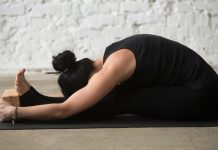In the world of yoga, there are poses that embody both strength and grace, and Dhanurasana, or Bow Pose, is one such asana. Derived from the Sanskrit words “dhanu” meaning bow and “asana” meaning pose, Dhanurasana mirrors the shape of a bow, representing the power, resilience, and openness within us. This article explores the significance and benefits of Dhanurasana, guiding you through its practice, and highlighting the transformative effects it can have on your physical and mental well-being.
What is Dhanurasana?
Dhanurasana is a backbend pose that engages the entire body. As you assume the shape of a bow, your arms and legs act as the strings, while your torso forms the bow’s body. This asana offers a deep stretch to the front and back of the body, requiring balance, strength, and flexibility.
What is the benefit of Dhanurasana?
Dhanurasana (Bow Pose) offers a wide range of physical, mental, and energetic benefits. Here are some of the key benefits:
1. Spinal Health: Dhanurasana is excellent for promoting spinal health. The pose stretches and strengthens the muscles along the entire length of the spine, improving flexibility and alignment. It helps counteract the effects of prolonged sitting or poor posture, reducing backaches and discomfort.
2. Improved Posture: By strengthening the muscles of the back, shoulders, and neck, Dhanurasana helps improve posture. Regular practice can alleviate rounded shoulders and promote an upright, aligned spine.
3. Increased Flexibility: Dhanurasana stretches the entire front body, including the chest, shoulders, abdomen, and hip flexors. With consistent practice, it gradually improves flexibility in these areas, allowing for greater range of motion and ease in other physical activities.
4. Strengthened Core and Legs: Holding the pose requires engagement of the core muscles, including the abdominal muscles and the muscles of the lower back. Additionally, the leg muscles, including the quadriceps and hamstrings, are activated and strengthened.
5. Enhanced Digestion: The compression of the abdomen in Dhanurasana massages the digestive organs, stimulating their functioning. This can help improve digestion, relieve constipation, and promote overall digestive health.
6. Increased Lung Capacity: The deep backbend in Dhanurasana expands the chest and ribcage, facilitating deeper and more expansive breathing. This can enhance lung capacity and improve overall respiratory function.
7. Emotional Release: Backbends like Dhanurasana can stimulate the release of emotional tension stored in the body. The opening of the chest and the stretching of the front body can create a sense of vulnerability and allow for emotional release, leading to a lighter and more open emotional state.
8. Energetic Benefits: Dhanurasana activates the Manipura Chakra, the solar plexus chakra, which is associated with personal power, self-confidence, and transformation. This can help increase vitality, boost self-esteem, and promote a sense of empowerment.
9. Stress Relief and Relaxation: Practicing Dhanurasana can help release physical and mental tension, promoting relaxation and reducing stress. The focused breathing and mindful awareness during the pose help calm the mind and cultivate a sense of inner peace.
How to perform Dhanurasana?
To perform Dhanurasana (Bow Pose), follow these step-by-step instructions:
1. Lie down on your stomach with your feet hip-width apart and your arms resting alongside your body, palms facing up.
2. Bend your knees and bring your heels close to your buttocks, keeping them hip-width apart.
3. Reach back with your hands and hold your ankles or feet, depending on your flexibility. Ensure your grip is firm yet comfortable.
4. Take a deep breath in and lift your chest off the ground. Simultaneously, kick your legs back, raising your thighs and knees off the mat. Your head, upper chest, and thighs should be lifted, while your abdomen remains in contact with the floor.
5. Keep your gaze forward and maintain a gentle smile on your face. Breathe deeply and hold the pose for 20 to 30 seconds, or as long as comfortable.
6. Exhale as you gently release your grip on the ankles or feet, lower your legs, and bring your upper body back down to the mat.
7. Relax in the prone position for a few breaths before repeating the pose if desired.
In conclusion, Dhanurasana, the Bow Pose, is a powerful yoga asana that not only challenges your physical abilities but also opens up channels for emotional and energetic transformation. With consistent practice, this pose can strengthen your body, increase flexibility, and foster a deeper connection with yourself.
Please note that it’s always recommended to learn and practice yoga asanas under the guidance of a qualified yoga instructor to ensure proper technique and avoid any potential injuries.











































